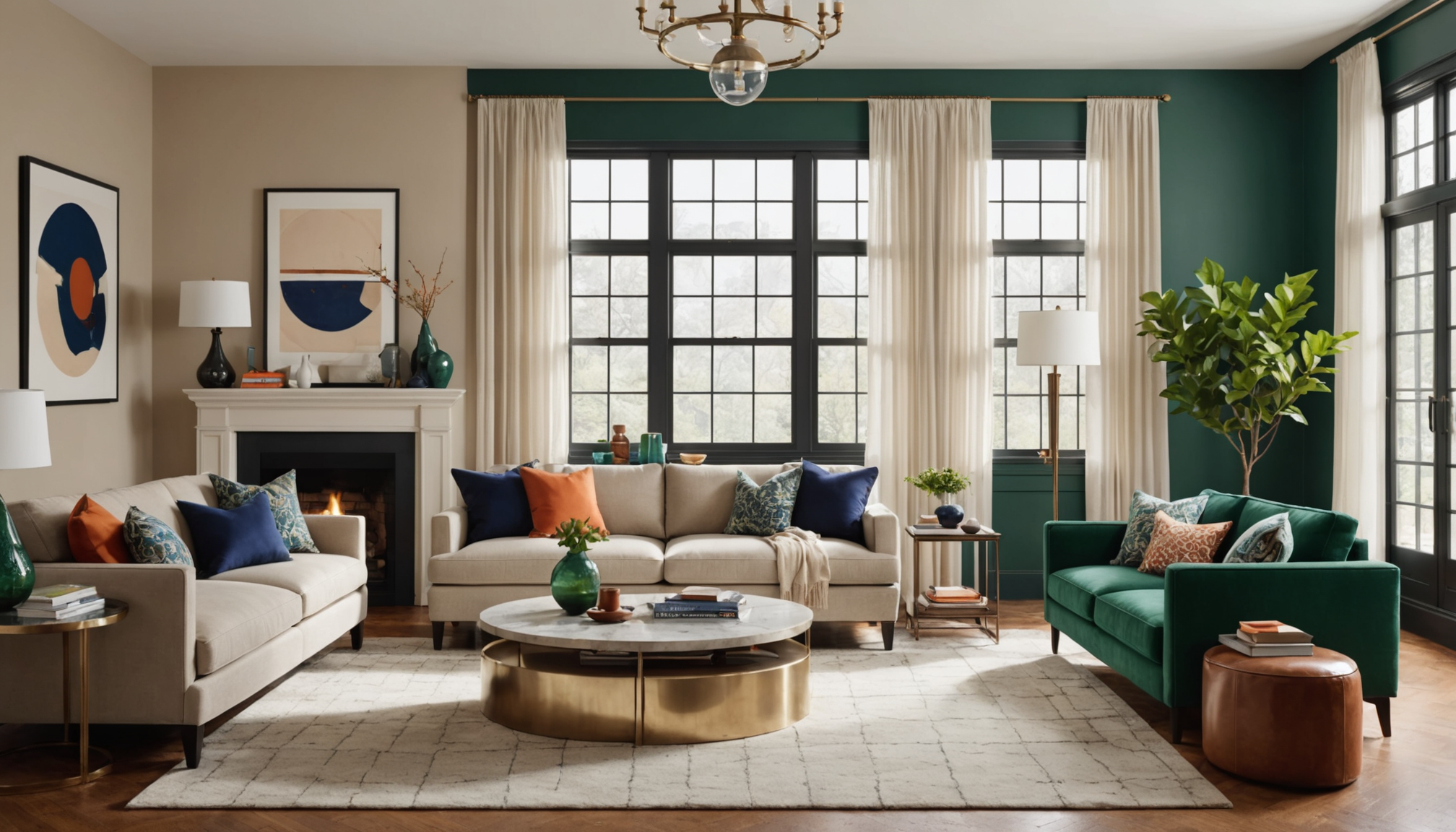Choosing the right color palette for your living room is a fundamental step in the home improvement process, especially when you’re planning to replace existing elements to create a modern and inviting space. The color scheme sets the tone for the entire room, influencing not just the aesthetic but also the mood and functionality of the space. A well-chosen palette can seamlessly tie together different components, from furniture and decor to lighting and flooring.
When selecting a color palette, consider the atmosphere you want to achieve. Do you want your living room to feel calm and cozy, vibrant and lively, or sophisticated and elegant? Start by exploring a range of hues, including neutrals, complementary colors, and bold accents, as each can contribute uniquely to the space. Neutral tones like beige, taupe, and gray can form a versatile backdrop, allowing for more flexibility in furniture and decor choices. Meanwhile, bolder shades like navy blue, emerald green, and burnt orange can make striking focal points.
For a modern flair and eco-friendly appeal, consider integrating natural colors inspired by the environment. Shades of green and earthy tones not only reflect a commitment to sustainability but also bring a touch of the outdoors inside, promoting a sense of tranquility. Additionally, these colors can adapt well to various lighting conditions, further enhancing the room’s ambiance.
The choice of finish also plays a crucial role. Matte finishes can offer a soft, understated look, while glossy finishes contribute to a sleek and polished appearance. Balancing these finishes can help highlight architectural details and create depth within the space.
Another practical consideration in choosing a color palette is the size of the room. Lighter colors can make a small living room appear larger and more open, while darker shades may add intimacy and warmth to a larger space. Here is a comparison table of the effects of light and dark color palettes:
| Aspect | Light Colors | Dark Colors |
| Space Perception | Makes room appear larger | Makes room feel cozier |
| Temperature Feel | Cooler and airy | Warmer and snug |
| Lighting Compatibility | Enhances natural light | Requires ample artificial lighting |
| Maintenance | Shows dirt and marks more easily | Disguises minor imperfections |
Ultimately, harmonizing your living room’s color palette with its intended purpose and style theme will contribute to a cohesive and pleasing environment. Engage with samples and perhaps even try temporary paint patches to see how the colors work together and under different lighting scenarios before making your final decision. By paying attention to these details, you can transform your living room into a space that truly reflects your style and meets your lifestyle needs.
Selecting furniture essentials
When looking to replace your living room furniture, it’s important to focus on essential pieces that will anchor the space and enhance its functionality and style. Begin by evaluating the room’s layout and size to determine what furniture is necessary and how it should be arranged. Follow these steps to ensure you make thoughtful and impactful choices:
1. Assess Your Needs:
– Identify how your living room is primarily used. Is it a space for relaxation, entertaining guests, or family gatherings?
– Consider the lifestyle and needs of your household. Families with children might prioritize durable materials, while single homeowners might focus on design and aesthetics.
2. Create a Floor Plan:
– Measure your space accurately to understand the dimensions you’re working with. You could use online room planners or draw a simple sketch.
– Think about the flow of the room and how people move through it, ensuring that essential pathways are clear.
3. Select a Sofa or Sectional:
– Choose a sofa that complements your color palette and fits comfortably within your space.
– Consider sectionals if you have a larger area or need more seating capacity. They can provide flexibility in arranging your room.
4. Incorporate Seating Options:
– In addition to the main sofa, include other seating options like armchairs or ottomans for versatility.
– If space permits, accent chairs can add both seating and style, offering a chance to introduce different textures or colors.
5. Choose a Coffee Table:
– Ensure the coffee table is proportionate to your seating arrangement — typically one third to two thirds the length of your sofa.
– Look for a table that serves both form and function with storage or display space for books and decor.
6. Add Side and End Tables:
– These provide additional surface areas next to seating for lamps or decorative items.
– Select styles that coordinate with your primary furniture pieces to maintain cohesion in your room’s aesthetic.
7. Consider Storage Solutions:
– Use entertainment units, media consoles, or credenzas to organize electronics, books, and other items.
– Integrate storage furniture that matches your overall design theme, emphasizing eco-friendly materials if sustainability is a priority.
8. Choose Multi-functional Pieces:
– Opt for furniture that offers additional functionality, such as a sleeper sofa for guests or an ottoman with storage.
– These flexible pieces enhance the usability of the room without compromising on style.
By systematically evaluating and selecting each piece, you can ensure your living room is a harmonious blend of style, comfort, and practicality. This deliberate approach will ultimately help you replace your living room furniture with items that not only meet your functional needs but also express your personal style and accommodate modern living.
Incorporating lighting design
Lighting design is crucial in transforming your living room into a space that is both inviting and functional. Thoughtful lighting can dramatically alter the room’s atmosphere, highlighting your design choices and enhancing overall comfort. Whether you’re aiming for a cozy retreat or a vibrant entertainment area, the right lighting design will complement your chosen color palette and furniture arrangement, maximizing the room’s potential.
Begin by considering the various layers of lighting that you can incorporate: ambient, task, and accent lighting, each serving a unique purpose. Ambient lighting is the primary source, which provides the room with overall illumination. It is typically achieved through ceiling-mounted fixtures such as chandeliers, recessed lights, or flush mounts. For a modern touch, consider using LED lights, which not only reduce energy consumption but also offer versatile color and brightness settings.
Task lighting focuses on specific areas where activities such as reading, working, or game playing take place. Floor lamps, table lamps, and adjustable wall sconces are ideal for creating dedicated zones of illumination. This type of lighting is particularly important if your living room doubles as a study or reading area. Positioning these lamps strategically near seating areas or workspaces can significantly enhance functionality.
Accent lighting is used to highlight certain features or décor elements in the room, such as artwork, shelving units, or architectural details. Spotlights, track lighting, and under-cabinet lighting are excellent choices for this purpose. These fixtures can add depth to the room and draw attention to focal points, enriching the space’s visual texture.
Incorporating dimmers is a pragmatic way to control light levels throughout the day and tailor the ambiance to specific activities or moods. They offer the flexibility to soften or intensify light, which can be particularly beneficial if you’re hosting gatherings or seeking a peaceful evening retreat at different times.
When selecting fixtures, consider how their design complements the room’s style. For a modern living room, streamlined and minimalist lighting choices can enhance a chic, contemporary aesthetic. On the other hand, a more traditional space might benefit from fixtures with classic details or vintage flair. It’s also essential to think about scale; oversized fixtures can become a statement piece, while smaller ones may blend subtly into the background.
Finally, don’t overlook the natural light your living room receives. Balancing natural and artificial light can significantly affect energy consumption and mood. Use window treatments like sheer curtains or blinds that allow you to regulate sunlight. For spaces aiming for eco-friendly solutions, choosing lights with energy-efficient technology can minimize your carbon footprint while still offering excellent illumination.
By carefully planning your living room’s lighting design, you can create an environment that not only showcases your home improvement efforts but also enhances day-to-day living. Effective lighting isn’t just about aesthetics; it’s about creating a space that serves your needs today while being adaptable for any future design changes.
Adding personalized decor touches
Infusing your living room with personalized decor touches is a rewarding venture that transforms the space into a unique reflection of your style and essence. Whether you’re looking to refresh your current setup or completely replace elements during a home improvement project, personalized decor remains an essential aspect of crafting a cozy and inviting atmosphere.
Start by considering elements that resonate with your personality and experiences. Displaying memories in the form of photographs, art pieces, or travel souvenirs can immediately warm the space. Create a gallery wall with a mix of frame sizes and styles for visual interest, allowing you to showcase family portraits alongside contemporary art. This eclectic mix embodies a modern aesthetic while telling your personal story.
Textures play a vital role in adding depth and comfort to your living room. Integrate a variety of textiles like plush rugs, knitted throws, and an array of cushions. Sustainable and eco-friendly materials can enhance comfort while supporting an environmentally conscious approach. Opt for organic cotton, linen, or bamboo fabrics which are both stylish and responsible choices.
Incorporating greenery through houseplants infuses your space with life and can improve air quality. Choose plants that align with your lifestyle—low-maintenance succulents or vibrant ferns for those who enjoy tending to greenery. A large indoor plant like a fiddle-leaf fig can act as a striking focal point, seamlessly blending with modern decor trends.
Don’t overlook the use of scent as a personal touch in your living room. Scented candles, essential oil diffusers, or incense can influence the room’s ambiance, offering calming or invigorating experiences according to your needs. Select fragrances that evoke pleasant memories or complement the mood you aim to create, ensuring this element enriches your sensory experience.
When it comes to selecting decorative objects, be intentional. Curate items that have meaningful stories or that resonate with your interests. This could range from antique vases to handcrafted sculptures, each piece adding a layer to the narrative of your living space. Displaying these items on open shelving or coffee tables provides an inviting view for guests and sparks conversation, making your living room both a personal retreat and an interactive social environment.
Mirrors can be strategically placed to enhance natural light and the illusion of space, crucial in optimizing smaller living rooms. Choose a design that complements your overall decor style—whether a sleek, frameless piece for a minimalist feel or an ornate frame for a traditional touch. Mirrors not only contribute to the aesthetics but also reflect your intentional design choices.
Personalization isn’t just about aesthetics; it also involves creating a functional, harmonious environment that suits your lifestyle. Tailor the room’s layout and decor to accommodate your daily activities. Whether it’s arranging a reading nook or establishing a dedicated space for hobbies, these customized touches are what make your living room genuinely yours.
By thoughtfully integrating personalized decor, you transform your living room from a generic space into a sanctuary of self-expression and comfort. With each addition, you turn your home improvement efforts into a testament to your individuality, making your living space a true extension of who you are. Remember, the goal is to craft a space you’re eager to retreat to, where every item tells your story and enhances the room’s functional beauty.
Maximizing space and functionality
When aiming to maximize space and functionality in your living room, a strategic approach can ensure that every square foot is utilized effectively without compromising on style. The first step to achieving this is assessing your current layout to determine areas that may benefit from reorganization. Begin by identifying high and low traffic areas within your living room to understand how space is currently used. This insight can guide you in making necessary adjustments to furniture placement, ensuring an open and inviting flow from one area to another.
Consider the versatility of each piece of furniture within your space. Opt for multi-functional furniture such as sofa beds, storage ottomans, or nesting tables that can adapt to various needs throughout the day. A well-chosen modular sectional can be reconfigured as necessary, providing flexibility in both small and expansive spaces. These pieces not only serve practical purposes but can also effortlessly enhance your home’s overall modern aesthetic.
Creative storage solutions are vital in enhancing both the room’s functionality and its visual appeal. Floating shelves, built-in bookcases, and wall-mounted units provide opportunities to store and display items without encroaching on floor space. Reflective surfaces like mirrored furniture or glass tables can create the illusion of a larger living room, distributing light effectively throughout the space.
Incorporating foldable or expandable furniture items is another clever way to tackle space restrictions. Extendable dining tables or desks can provide extra work or hosting areas when needed without permanently occupying valuable real estate. Similarly, collapsible chairs or stools can be easily stored away when not in use, making them perfect for smaller living spaces.
The strategic design of pathways and zones within your living room is essential for maintaining its functionality. Group seating areas around focal points such as a fireplace or a media console to create natural congregation areas, and leave ample room for movement between zones. Ensure that your layout’s design supports both social interaction and relaxation, catering to various occasions from daily living to entertaining guests.
Lighting plays a crucial role in maximizing a living room’s perceived space. Layered lighting arrangements, utilizing a combination of recessed lighting, floor lamps, and task lights, enable you to tailor the ambiance based on specific activities or times of day. Ensuring adequate illumination can prevent crowded spaces from feeling cramped while highlighting key areas of the room.
Importantly, each functional enhancement should complement your living room’s style and color palette. Opt for eco-friendly materials wherever possible, which can offer both durability and sustainability. Natural wood finishes, recycled materials, and low-VOC paints contribute to a healthier living environment and can adapt to a variety of decor styles, from rustic to contemporary.
In creating a living room that is both spacious and functional, the ultimate goal is to reflect your personal lifestyle while incorporating practical solutions. By deploying smart design strategies and leveraging flexible furniture options, you can replace an outdated setup with a modern, efficient living space that meets your home improvement aspirations. Embrace the opportunities for innovation and creativity as you revitalize your living room, crafting a space that supports your needs today and into the future.
In conclusion, transforming your living room is a rewarding endeavor that encompasses thoughtful choices in color, furniture, lighting, decor, and space management. By prioritizing functionality while incorporating personal touches, you create a space that not only meets your current needs but also adapts to future changes, offering lasting comfort and style for years to come.


